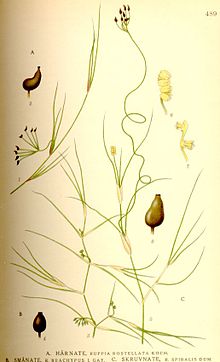Ruppiaceae
| Ruppia | |
|---|---|
 |
|
| Ruppia rostellata, R. brachypus, + R. spiralis |
|
| Scientific classification | |
| Kingdom: | Plantae |
| (unranked): | Angiosperms |
| (unranked): | Monocots |
| Order: | Alismatales |
| Family: |
Ruppiaceae Horan. |
| Genus: |
Ruppia L. |
| Synonyms | |
|
|
Ruppia, also known as the widgeonweeds,ditch grasses or widgeon grass, is the only genus in the family Ruppiaceae with eight known species). These are aquatic plants widespread over much of the world. The genus name was given in honour of Heinrich Bernhard Rupp, a German botanist (1688-1719). They are widespread outside of frigid zones and the tropics.
The leaf is simple and not rhizomatous. They can be annual (commonly) or perennial (rarely); stem growth is conspicuously sympodial, but sometimes is not. These species are adapted to be in brackish water (and salt marshes). The leaves are small or medium-sized. Their disposition can be alternate, opposite, or whorled (usually alternate except when subtending an inflorescence). Even, lamina keep entire and are setaceous or linear. The leaf just shows one vein without cross-venules. Stomata are not present. The mesophyll leaks calcium oxalate crystals. The minor leaf veins do not present phloem transfer cells and leaks vessels.
These plants have stems without secondary thickening and xylem without vessels. The sieve-tube plastids are P-type. The root xylem does not present vessels.
These plants are hermaphroditic, with anemophilous or hydrophilous pollination. The flowers are ebracteate, small, and regular. Commonly, the flowers are aggregated in ‘inflorescences’, but sometimes they are solitary. Often, they grow in racemes, spikes, or umbels. The scapiflorous inflorescences are terminal, in short spikes, or subumbelliform racemes, sometimes one- or few-flowered. They do not have hypogynous disks. These flowers do not have perianth absent, except when small staminal appendages are regarded as perianth segments. The androecial members are all equal. The androecium just presents two fertile stamens with sessile anthers dehiscing by longitudinal slits. The pollen is polysiphonous and its grains are three-celled and nonaperturate. The gynoecium (2–)4(–16) is superior, carpelled, and euapocarpous. The carpel is not stylate, apically stigmatic with the stigma peltate, or umbonate. These flowers only present one ovule pendulous, nonarillate, campylotropous, bitegmic, and crassinucellate. The placentation is apical and embryo-sac development is of the polygonum type. Before fertilization, they fuse polar nuclei. The fruit is drupaceous and fleshy, forming an aggregate. The fruiting carpel is indehiscent, commonly on a long, spirally twisted peduncle, with each drupelet becoming very long-stalked. The fruit contains one nonendospermic seed with starch. The embryo can be straight or slightly curved. Membranous testa do not have phytomelan.
The Cronquist system of 1981 placed the family in order Najadales of subclass Alismatidae in class Liliopsida [=monocotyledons] in division Magnoliophyta [=angiosperms].
...
Wikipedia
